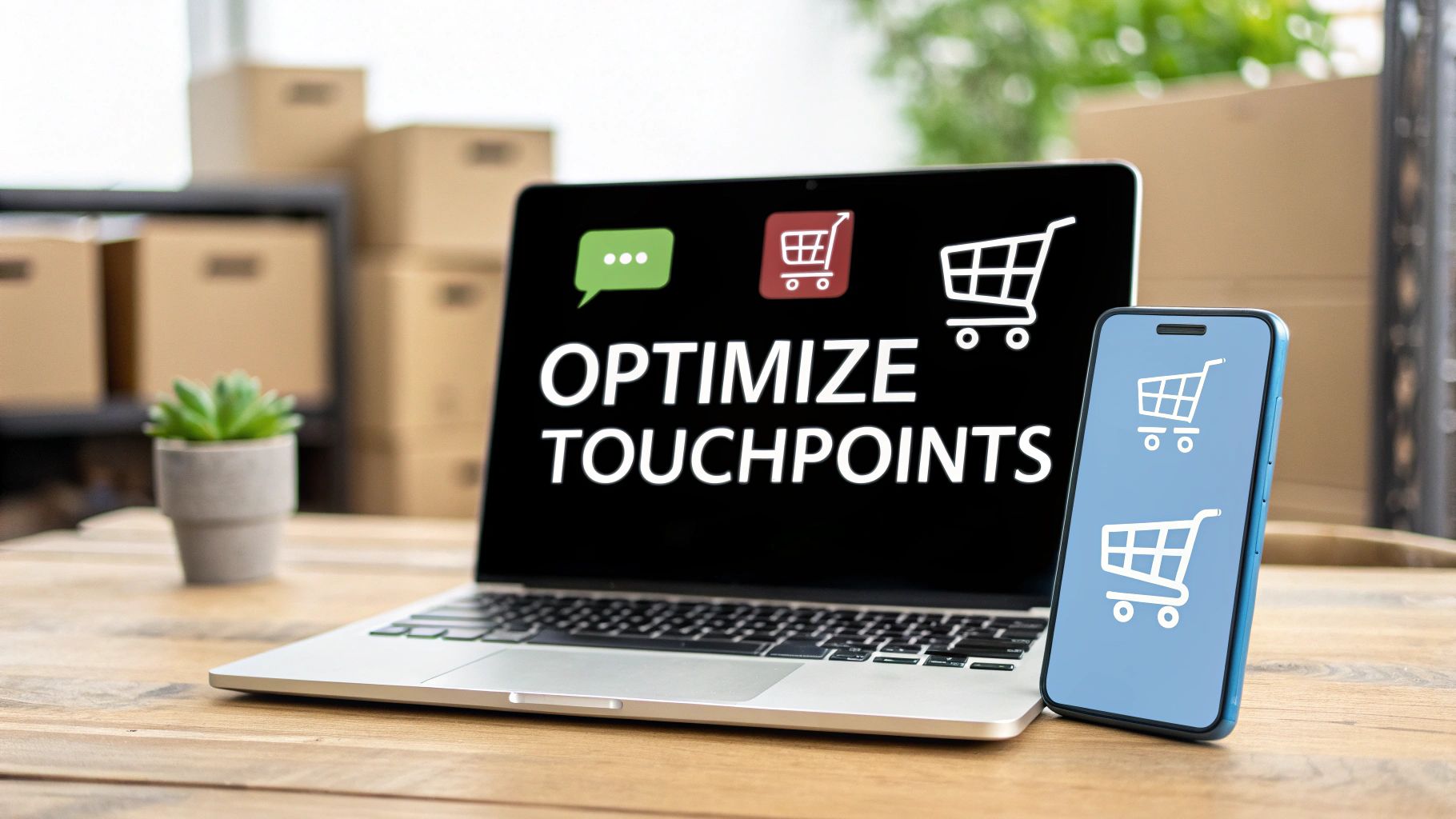Ever stare at your analytics, wondering why 98% of your website visitors leave without buying? It's a massive frustration for e-commerce brands, but the problem often isn't your product. It's a breakdown in your customer touch points.
A customer touchpoint is any interaction a person has with your brand. Think of it as every single "hello" along their path to becoming a customer. A common mistake we see is brands pouring all their energy into flashy ads but neglecting the small, subtle interactions that truly shape customer perception. In this guide, you'll learn exactly what customer touch points are, how to map them, and how to use WhatsApp to optimize the moments that matter most.
Your Guide to Mastering Customer Touchpoints
From our experience with over 500 Shopify stores, we’ve noticed a pattern. Merchants focus on big moments, like an Instagram ad or the checkout page, but miss the dozens of smaller interactions that build trust or create friction.
It's easy to underestimate how many of these moments it takes to earn a sale. Each one is a chance to build loyalty or send a potential buyer running. Did you know the average number of touchpoints per purchase is around 28.87 across all industries? This proves one thing: a single ad is rarely enough. You can dive deeper into the data and see industry-specific touchpoint benchmarks on Focus Digital.
Why Every Touchpoint Matters
Picture your customer's journey as a chain. A potential buyer moves from one link to the next—from seeing your ad to browsing your site, reading reviews, and finally, getting that shipping confirmation. If one link is weak—say, a slow-loading page or a confusing return policy—the whole chain can snap. You’ve lost a sale.
Getting these interactions right separates a one-time visitor from a loyal fan who boosts your Lifetime Value (LTV)—one of the most important metrics for sustainable growth.
The goal isn't just to make a sale. It's to create a seamless, positive experience at every step, so customers not only buy but also come back and tell their friends. That's how you build a resilient, profitable brand.
In this guide, we’ll show you exactly how to find, map out, and improve these crucial interactions. We’ll break down what customer touchpoints are and show you how to turn them into conversion drivers, with real examples from brands we've helped.
Understanding the Three Stages of Customer Touchpoints
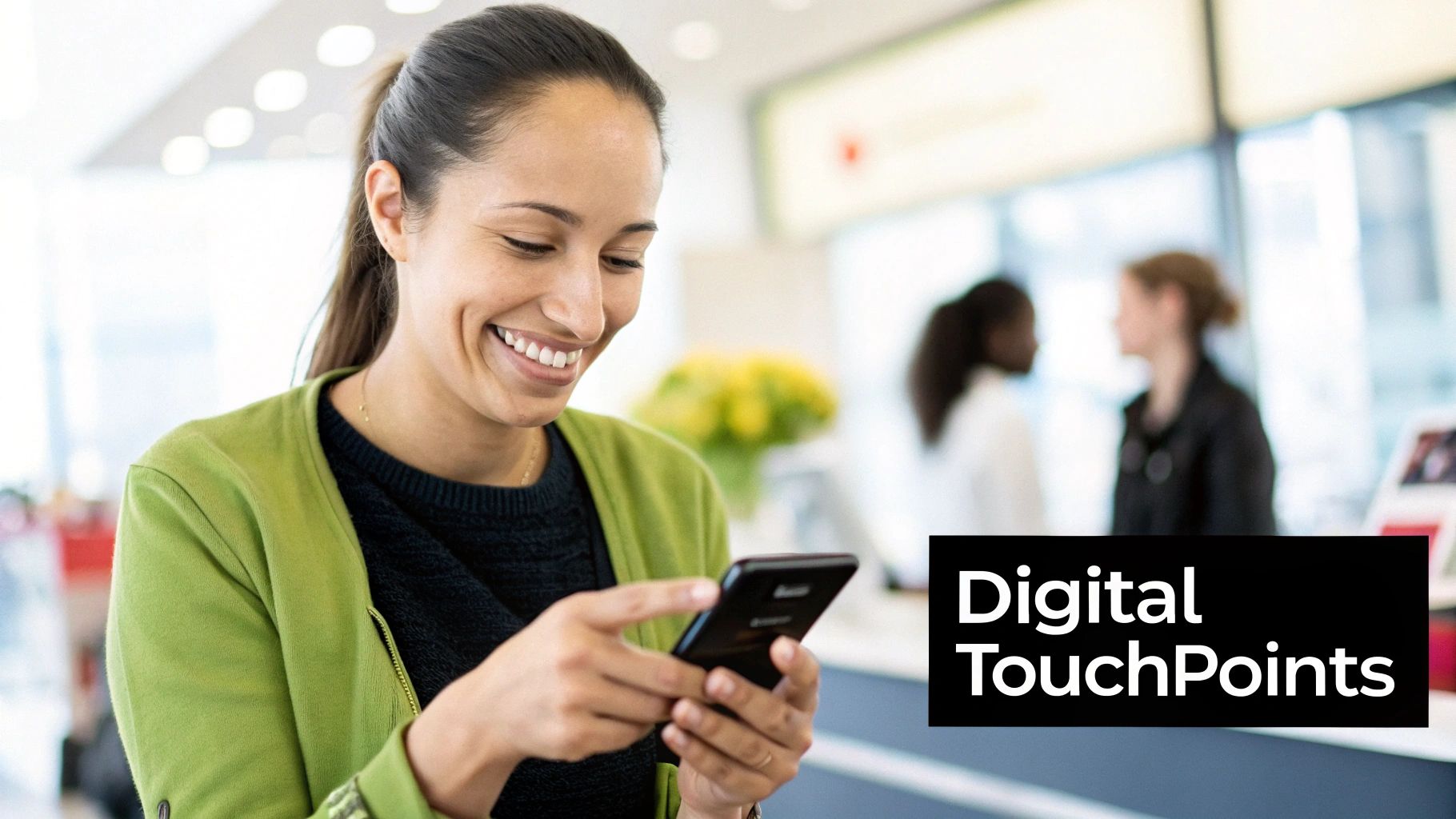
Not all touchpoints are created equal. Trying to fix every single one at once is a surefire way to get overwhelmed. The strategy that works time and again is to map your interactions across three clear stages: Before, During, and After the purchase.
After working with over 500 Shopify stores, we've seen firsthand how brands that adopt this framework get a real lift in conversion rates and customer lifetime value (LTV). It’s effective because it forces you to step into your customer's shoes and give them what they need, right when they need it.
Let's break down each stage with actionable examples.
Before Purchase: The Awareness and Consideration Stage
This is where it all starts. The "Before Purchase" stage covers every interaction someone has with your brand before they add something to their cart. The goal here isn't to make a sale; it's to get noticed, build trust, and be genuinely helpful.
A classic mistake we see is going for the hard sell way too early. Your customer is just exploring and looking for solutions. Your job is to be the helpful guide, not the pushy salesperson.
Here’s what that looks like in practice:
- Social Media Ads: A well-targeted Instagram ad that shows how your product solves a real problem.
- Content Marketing: A blog post (like this one!) optimized to answer a question your ideal customer is typing into Google.
- Influencer Mentions: A creator their audience trusts showing off your product in an authentic way.
- Product Reviews: What real people are saying about you online. This is powerful social proof.
- Website Pop-ups: A timely offer for a discount in exchange for signing up for your WhatsApp list.
Actionable Tip: Review your top-of-funnel content. Is it all "buy now"? Shift your messaging to be more educational. You'll build trust that pays off later.
During Purchase: The Decision Stage
This is the moment of truth. The "During Purchase" stage covers those critical moments from when a customer lands on a product page to the second they click "Complete Order." This is where most sales are lost to cart abandonment, so every touchpoint needs to be smooth and reassuring.
Friction is your mortal enemy here. A clunky checkout form or a surprise shipping fee can kill a sale in a heartbeat. We've seen clients reclaim thousands in lost revenue just by tightening up these crucial steps.
The touchpoints that matter most at this stage are:
- Product Pages: High-quality photos, compelling descriptions, and easy-to-find user-generated content.
- Shopping Cart: A simple, clean summary of the items and costs. No surprises.
- Checkout Process: A mobile-friendly form that offers guest checkout. Don't force them to create an account.
- Live Chat/Support: Instant access to help for last-minute questions. This is a perfect spot for a WhatsApp chat integration.
- Abandoned Cart Messages: A friendly reminder sent via email or—for much higher open rates—a WhatsApp message from Kanal.
After Purchase: The Retention and Advocacy Stage
You made the sale, but the journey isn't over. The "After Purchase" stage is where you turn a one-time buyer into a loyal fan.
Skipping this stage is one of the costliest mistakes an e-commerce brand can make. Acquiring a new customer is up to five times more expensive than keeping an existing one. This is your chance to deliver a standout experience that eliminates buyer's remorse and gets people talking.
High-impact touchpoints in this final stage include:
- Order Confirmation: An instant, reassuring message that confirms all purchase details.
- Shipping Updates: Proactive notifications letting them know their order is on the way.
- Feedback & Review Requests: A polite, well-timed request for a review after the product has been delivered.
- Loyalty Program Invites: An exclusive invitation to your VIP club to make them feel special.
- Personalized Follow-ups: A targeted message with tips on using their new product or recommendations for complementary items.
By splitting your customer's journey into these three stages, you can pinpoint exactly where things are going right and where people are dropping off.
How to Map Your Customer Touchpoint Journey
Mapping your customer touchpoints is a powerful exercise you can—and should—do yourself. Think of it as creating a visual blueprint of every single interaction a person has with your brand, from first glance to their second purchase.
Why bother? Because this map will shine a spotlight on the hidden cracks in your funnel where you're leaking money. A common trap we see is businesses pouring cash into ads while neglecting small friction points—like a confusing returns policy or a slow-loading cart—that kill conversions.
Walking through this process gives you an honest look at your business from the only perspective that matters: your customer's. The goal is to create a smooth, intuitive experience that builds trust and guides people toward a purchase.
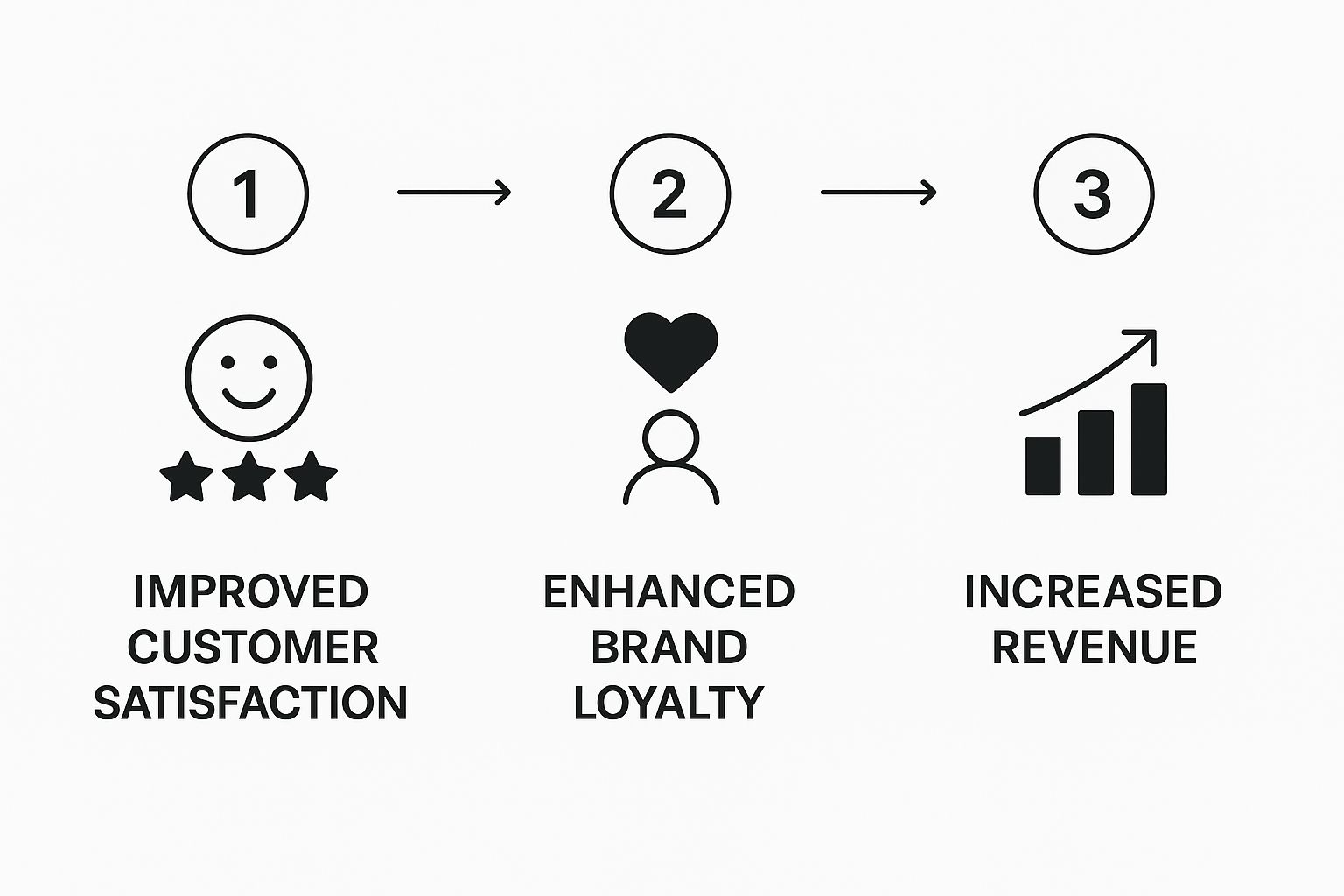
As you can see, improving satisfaction is the first domino to fall. It leads directly to building a loyal customer base, which is the real engine for sustainable growth.
Step 1: Identify Every Possible Touchpoint
First, brainstorm every single way a customer could possibly interact with your brand. Don't second-guess yourself; just get everything down. To make it manageable, break it down by the three stages we discussed: Before, During, and After purchase.
- Before Purchase: How do people discover you? Think Instagram ads, Google searches, blog posts, influencer mentions, and word-of-mouth.
- During Purchase: What happens on your site? This includes their visit to a product page, adding an item to their cart, the checkout flow, payment options, and live chat.
- After Purchase: How do you keep the conversation going? This includes the order confirmation email, shipping notifications, the unboxing experience, customer support chats, and review requests.
Pro Tip: Don't forget the offline world! The product packaging itself is a massive touchpoint. The feeling a customer gets when unboxing their order can be just as impactful as your website's design.
Step 2: Put Yourself in Your Customer’s Shoes
Now, do a little role-playing. Go through the entire journey as if you were a brand-new customer. Click on one of your ads, navigate your site on a phone, and try to buy something.
As you move through each touchpoint, ask yourself these gut-check questions:
- What am I trying to accomplish right now?
- Is the brand making this easy for me?
- What am I feeling? Excitement? Confusion? Frustration?
- Does this interaction build trust or create doubt?
This hands-on approach is critical. The old idea of a linear customer journey is gone. Today's paths zig-zag across dozens of touchpoints before a decision is made.
Step 3: Pinpoint Moments of Truth and Friction
With notes from your walkthrough, it’s time to analyze your findings. You're looking for two things: Moments of Truth and Points of Friction.
- Moments of Truth: These are the make-or-break interactions that have an outsized impact on a customer’s decision. It could be the clarity of your product descriptions, the simplicity of your checkout, or how quickly your support team responds.
- Points of Friction: These are the frustrating hurdles that cause people to leave. Think of unexpected shipping costs, being forced to create an account, or a broken 404 page.
By zeroing in on these key moments, you can prioritize what to fix first. This turns a vague problem like "our conversion rate is low" into a clear, actionable to-do list. To dig even deeper, check out our complete guide on how to create a customer journey map for your store.
Supercharge Key Touchpoints with WhatsApp Marketing
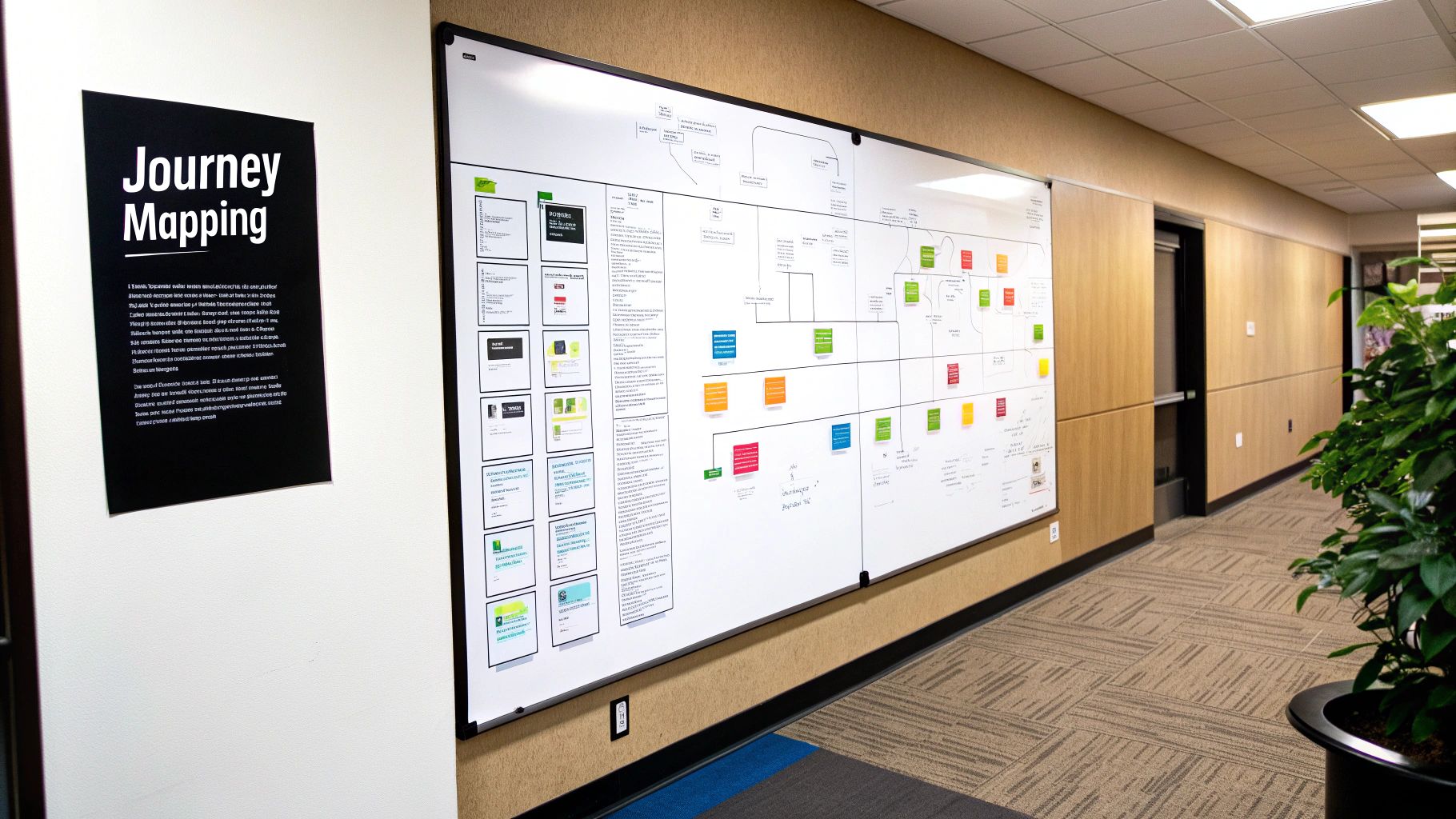
Once you've mapped your journey, it's time to optimize your most important customer touchpoints. While email and SMS still have a role, the strategy that consistently moves the needle for our clients is bringing WhatsApp into the mix.
With a jaw-dropping 98% open rate, a WhatsApp message is almost guaranteed to be seen. This makes it the perfect tool for high-stakes moments where being ignored isn't an option.
As an official Meta Business Partner, we've seen thousands of brands use Kanal to turn these interactions into revenue drivers. Let’s walk through three high-impact automations you can set up today.
The Welcome Flow That Converts
The moment someone subscribes to your WhatsApp list is pure gold. They're interested and paying attention. A huge mistake we see is sending a generic "Thanks for subscribing!" and letting that warm lead go cold. You need a strategic welcome flow that instantly builds a connection and nudges them toward their first purchase.
Here’s a field-tested template that works:
Message 1 (Sent Immediately):
"Hey [FirstName]! Welcome to the [Brand Name] family. We're so glad you're here! To say thanks, here's 15% off your first order. Use code: WELCOME15 at checkout. Happy shopping! 😊"Message 2 (Sent 24 Hours Later):
"Hi [FirstName], just wanted to share what our customers are loving most! Our best-seller this week has been the [Product Name]. People are raving about it! Check it out here: [Link to Best-Seller]"
This one-two punch starts with a clear incentive and follows up with social proof, making the decision to buy much easier.
The Abandoned Cart Flow That Recovers Sales
Cart abandonment is the silent killer of e-commerce profits. The average cart abandonment rate hovers around a painful 70%. That means seven out of ten customers who add an item to their cart walk away.
Email reminders get buried, but a well-timed WhatsApp message cuts through the noise. Our clients using Kanal's abandoned cart flows see recovery rates 3-5x higher than with email alone.
Here’s a proven template for getting those sales back:
Message 1 (Sent 1 Hour After Abandonment):
"Hey [FirstName]! Looks like you left some amazing items in your cart. Did you have any questions before you check out? We're here to help! Your cart is saved here: [Link to Cart]"Message 2 (Sent 23 Hours Later):
"Hi [FirstName]! Still thinking it over? We saved your cart for you, but these items are popular and might sell out. Complete your order now and we'll throw in free shipping! [Link to Cart]"
The first message is friendly and helpful. The second introduces urgency and a final incentive. This combination is incredibly powerful for rescuing lost revenue.
The Post-Purchase Flow That Builds Loyalty
You made the sale—congratulations! Now, the most important part begins: turning that buyer into a loyal customer. The post-purchase experience is your chance to eliminate buyer's remorse, collect valuable reviews, and pave the way for their next purchase.
Here’s how you can automate this crucial touchpoint:
Message 1 (Sent After Delivery):
"Good news, [FirstName]! Your [Brand Name] order has been delivered. We hope you love it! Let us know what you think."Message 2 (Sent 7 Days After Delivery):
"Hi [FirstName], how are you enjoying your [Product Name]? If you're loving it, would you mind leaving a quick review? It helps us a ton! [Link to Review Page]"Message 3 (Sent 21 Days After Delivery):
"Hey [FirstName]! Since you liked the [Product Name], we thought you'd love this. Based on your purchase, here's a special recommendation just for you: [Link to Recommended Product]. Enjoy!"
This sequence confirms delivery, secures social proof, and uses purchase data to make a smart, personalized recommendation. It’s a fantastic way to boost Customer Lifetime Value (LTV).
By using a dedicated WhatsApp integration, you can automate these flows and sync them directly with your Shopify data, ensuring every message is perfectly timed and relevant.
Continuously Improve Your Touchpoint Strategy
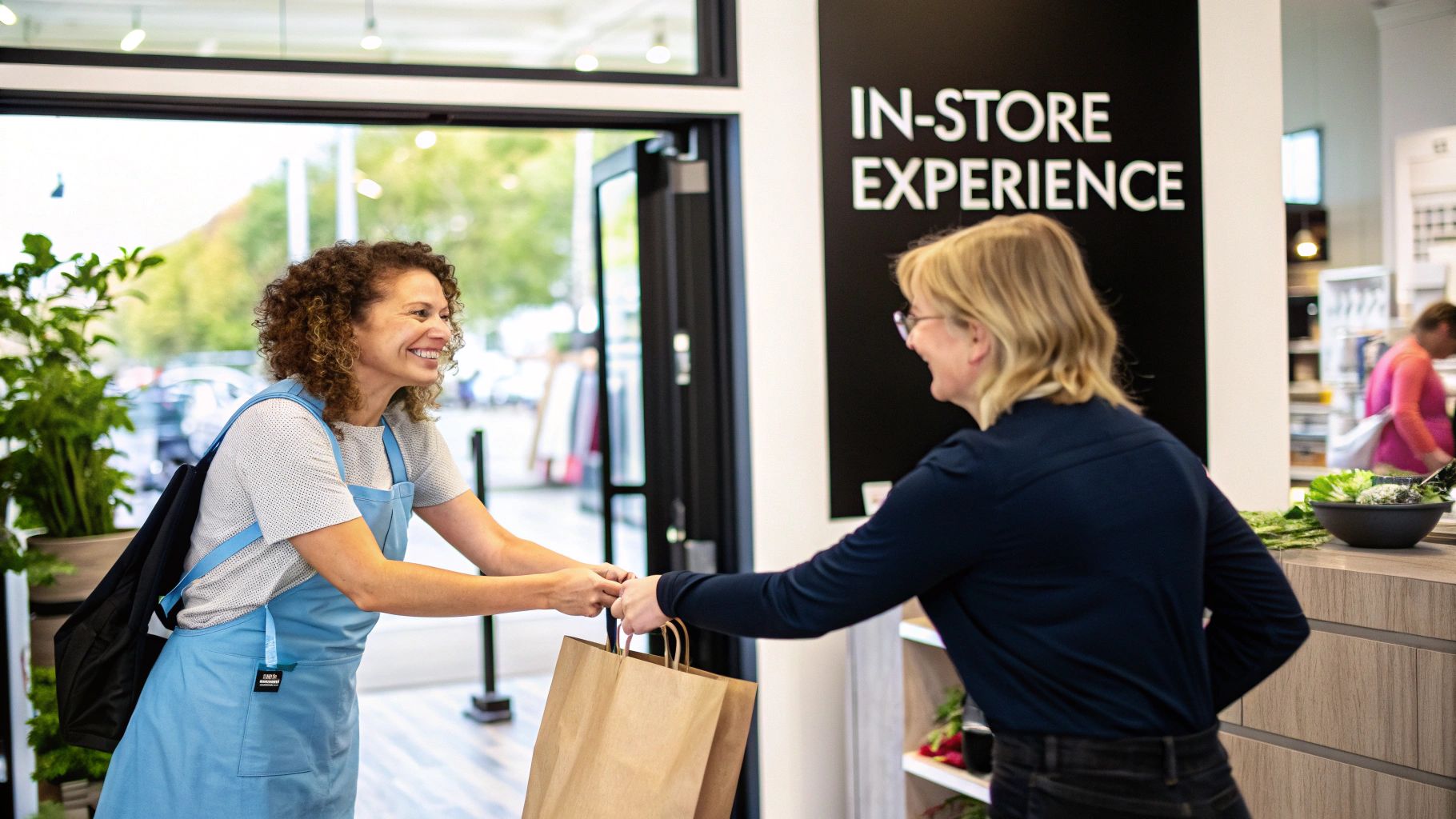
Mapping your customer journey is a fantastic first step, but it’s not a one-and-done project. Customer needs change and your brand evolves. A touchpoint map that’s brilliant today could be leaking revenue in six months. The final, most important step is to build a system for continuous improvement.
From what we've seen, the brands that achieve sustainable growth are obsessed with data. They measure what matters, test their assumptions, and constantly tweak their approach. This mindset transforms your touchpoint map from a static document into a dynamic growth engine.
Measure What Matters Most
You can't fix what you don't measure. It's easy to get lost in vanity metrics, but you should focus on the Key Performance Indicators (KPIs) that directly affect your bottom line.
When we work with Shopify merchants, we guide them to zero in on a handful of core metrics for their WhatsApp flows. Here are the essentials you should be tracking:
- Conversion Rate: What percentage of people who get your abandoned cart message actually buy? This tells you exactly how effective your message is.
- Engagement Rate: Are people clicking your links or replying? High engagement is a great sign that your content is hitting the mark.
- Opt-Out Rate: If you see a spike in unsubscribes after a specific message, it’s a huge red flag that your timing, offer, or tone is off.
- Revenue Per Recipient (RPR): How much money does each WhatsApp message bring in, on average? This metric shows you the direct ROI of your efforts.
You can find all of these metrics inside the Kanal dashboard, which pulls data directly from your Shopify store. For broader website touchpoints, Google Analytics is your best friend for seeing where users are dropping off.
Run Simple A/B Tests to Find What Works
Once you know your baseline numbers, start experimenting. A/B testing is simple: you create two versions of something (Version A and Version B), send them to different groups, and see which one performs better.
A classic mistake we see is brands testing too many things at once. If you change the headline, offer, and image, you'll have no clue which change made the difference.
The strategy that consistently delivers the best results for our clients is to test one variable at a time. Keep it simple. Did a 15% discount outperform free shipping? Did sending a message after one hour work better than after three?
Here are a few easy A/B tests you can run on your WhatsApp messages using Kanal:
- The Offer: Pit a percentage discount (15% off) against a fixed amount ($10 off) or a value-add (free shipping).
- The Copy: Try a friendly, casual tone versus a more direct, urgent one. Test using emojis vs. no emojis.
- The Timing: For abandoned carts, experiment with sending the first nudge after 30 minutes, 1 hour, or 4 hours.
By constantly testing, you let your customers tell you what they want. For more ideas, applying proven conversion rate optimization tips is a great way to keep refining your touchpoints. This continuous loop of measuring, testing, and tweaking is how you build a journey that doesn't just convert more shoppers, but also boosts your customer LTV—which you can monitor with our free customer lifetime value calculator.
Frequently Asked Questions About Customer Touchpoints
https://www.youtube.com/embed/cgAxnjVBKyM
We talk to e-commerce brands about customer touchpoints all the time, and a few key questions always pop up. Let's dig into some of the most common ones we hear.
How Many Touchpoints Does It Take to Make a Sale?
This is the million-dollar question. The honest answer is, "it depends." There's no magic number because every customer's journey is different, depending on their awareness of your brand and the problem you solve.
Data shows a wide range. Winning back a lapsed customer might only take 1 to 3 touches. A warm lead who already knows you might need 5 to 12 interactions. But for a cold prospect who has never heard of you, you could be looking at 20 to 50 touchpoints. For a closer look at the numbers, EmailToolTester has some great data on sales touchpoints.
Which Touchpoints Should I Fix First?
It's easy to get overwhelmed. The strategy that works time and again is to focus on the points of highest friction and highest impact.
Start in the middle of the journey: the "During Purchase" stage. Your product pages, shopping cart, and checkout flow are where money is made or lost. A clunky checkout or a surprise shipping cost can instantly kill a sale. Tackling cart abandonment is often the lowest-hanging fruit with the biggest payoff. For more ideas, check out our guide on how to increase customer engagement at these crucial moments.
What Role Does Automation Play in This?
Automation isn't about removing the human element—it's about delivering personal, timely interactions at scale. It's impossible to manually send a cart reminder exactly one hour after someone leaves your site. But with a tool like Kanal, that's exactly what you can do.
Automation ensures your most critical touchpoints—like welcome messages, abandoned cart reminders, and shipping updates—are timely, personal, and consistent. This frees you up to focus on strategy, creating a better experience for your customers and driving more revenue for your store.
By understanding what customer touch points are and how to optimize them, you can build a journey that converts shoppers into loyal fans. Ready to turn your most important touchpoints into powerful conversion engines? Install Kanal on your Shopify store today or get a personalized demo to see it in action.

